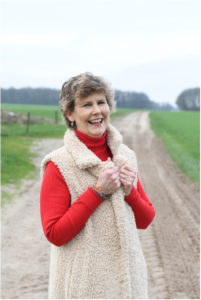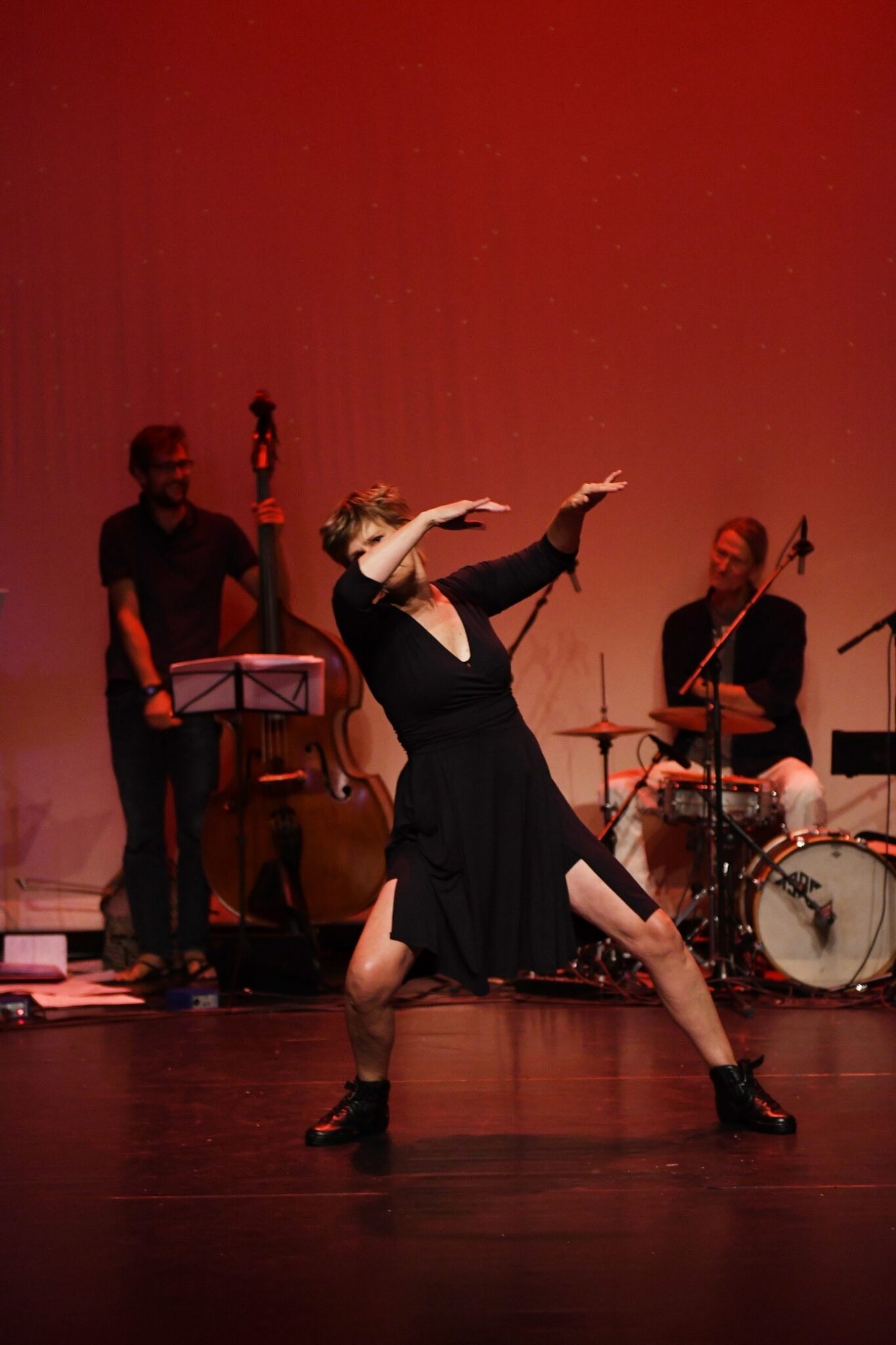An interview with Sabine Woertman from Advocacy in the Netherlands on February 18, 2024, by George Ackerman, Ph.D., J.D.

Biography
I have been dancing since my early childhood and worked as a movement therapist in promoting healthy activity. I had a practice for movement therapy, treating individuals from young to old with (for example) posture issues, hyperventilation, and conditions ranging from rheumatism to Parkinson’s. In recent years, I worked as a sleep movement therapist.
I am 54 years old and received the Parkinson’s diagnosis in 2015, already having symptoms for three years at that time. I live in the Netherlands.
Please tell me a little about your background.
When I received the diagnosis, I was in the midst of additional training to become a sleep movement therapist. I continued for a few years until the cases of my clients began affecting my own sleep. After one year of my diagnosis, I pursued training as an inclusive dance teacher, focusing on dance for people facing movement challenges such as M.S., rheumatism, and Parkinson’s. I was inspired by dance for Parkinson’s programs in the U.S. and the U.K. Positive engagement with Parkinson’s through my passion for dance resonated deeply with me. I have been teaching for seven years now, leading three classes a week. It requires energy, but it also replenishes me. Through dance, you momentarily forget your chronic condition; everything is good in dance, whether you lift your arm high or just your pinky. The music and emotion make you feel so much better.
Can you tell me more about your organization?
Due to numerous lessons and workshops, I attended, including those by David Leventhal (danceforpd), Annemarie Labinjo (ScapinoBallet), Marc Vlemminx (Dance for Health), Andrew Greenwood (Switch two move), Danielle Jones (Luminelle), Pamela Quinn (PDmovementlab), I can offer a variety of lessons to my dancers. From small choreographies to improvisations, we cover a wide range. Everyone is welcome, and everyone should feel completely at ease in my classes.
As both a teacher and a patient, my dancers sometimes witness me battling Parkinson’s, creating an extra bond
What is your passion and how did you get involved in Parkinson’s awareness and hope for a cure?
I have participated in events to introduce the public to dance, getting them moving because sitting still and listening is challenging for people with Parkinson’s. Moving is a welcome change during conferences, preventing cramps or tremors that can occur with prolonged sitting.
https://youtu.be/ykXUF7-wtJI?si=SMpj-OWzc8x9OK01 (2020)
https://youtu.be/JhQtykoFdGA?si=uXl-MVJqib5x8SmK (2021)
What type of goals do individuals with Parkinson’s have when working with you?
Movement is crucial in managing Parkinson’s; it keeps both your body and brain in the best condition. Dance involves moving to music, engaging both your body and brain simultaneously. The rhythm or melody makes movement easier, and the coordination trains your brain. The emotions evoked by music create new pathways in your brain, helping you cope better with Parkinson’s. I firmly believe that my extensive dancing has helped me navigate life with Parkinson’s, despite some decline. I aim to contribute to the Parkinson’s community by incorporating people into dance and movement. While I am an independent practitioner, I hope to join larger initiatives in the Netherlands in the future. Currently, there is no national organization for this, but I maintain close contact with my fellow teachers in the Netherlands and around the world.
choreografie “Red Yellow and Black” WPC 2030
What would you like to see as a future goal for your programs?
I have also engaged healthcare professionals in movement. Currently, there is a dance4parkinson challenge going on, for which I, along with my colleague Natalie Lewin, created the choreography. People can use this choreography to create their dance video, spreading awareness for Parkinson’s. The initiative is led by Prof Bas Bloem, and it was amazing to film the opening video with him in the park in Nijmegen. @instagram @dance4parkinsonchallenge send your video to dance4parkinson@gmail.com
What events do you participate in?
I attended the World Parkinson Congress in Barcelona, and danced during the opening ceremony in the choreography of Pamela Quinn “Red yellow and Black”, establishing new connections and strengthening existing ones. Dance transcends all boundaries; you don’t need to understand each other’s language for dance to connect you. It’s truly beautiful!
How does this also assist the caregivers?
Dance brings joy and energy, even if you attend a dance class once a week. The classes last an hour, followed by coffee or tea together, an essential part of the experience. Partners are always welcome to join, adding positive energy to the relationship. So, don’t stay at home; find a group to dance with, or engage in other forms of movement. It helps yourself, your partner, and others!
How can someone get in touch? What is your website?
My website: www.beweegendans.nl Sabine Woertman-Bode insta/fbBovenkant formulier
How can others also become advocates for awareness?
Educate yourself about Parkinson’s so that you can take care of yourself or assist your caregiver in helping you. Make informed choices and communicate effectively with your neurologist.
Pam Quinn Sabine Woertman WPC 2023
In your opinion what is the key to effective advocacy?
In addition to dancing, I go to the gym to work on my fitness, walk a lot with my dog, and attend dance classes regularly to inspire myself and relax. I recently underwent Deep Brain Stimulation (DBS) to continue dancing despite off periods and dyskinesia. I am currently in the adjustment phase, so I can’t share the final results yet. I am pleased not to suffer anymore from dyskinesia; That’s at least already one victory!
What other activities do you undertake to help improve and support your daily living Eg exercise and alternative remedies?
I also pay attention to my diet and try to eat as healthily as possible.
If you had one song that would tell us more about you or represent your life, which song would it be?
I participated in a theater performance about living with Parkinson’s, where I performed a solo dance expressing what Parkinson’s has done to my life. I danced to the song “Fields of Gold” by Eva Cassidy, a beautiful song that evokes memories of your life as it was before having PD. It’s also a song of hope, a reminder not to lose each other (as partners) and to go on and continue together.
On world Parkinson’s day 2023 I made a vlog for Parkinson T.V. (the Netherlands) what I do to keep going, I’m sorry it is in Dutch. https://youtu.be/cftoQ1fb9rc?feature=shared
Short translation; make a routine that you can cope with and hold on to every day. Same time medication and exercising. Discipline holds on to your workout, walk, whatever, every day. Go out and meet other pwp’s! I meet other PWP’s at the Yopper café which I help to organize. Especially when you live with PD and you had the diagnosis before turning 50. You probably have still children at home living, and you are in the middle of the working world. And to talk to other PWP who are coping with the same difficulties will definitely help you! Also, for caregivers!
If you had one final statement or quote you could leave for the Parkinson’s community, what would it be?
Together, we must overcome Parkinson’s. Whether we stand up for Parkinson’s awareness ourselves or have a family member do it for us, the more people know about Parkinson’s and its impact, the more awareness and funds there will be for research. Together is the key, and dancing is always done together!

